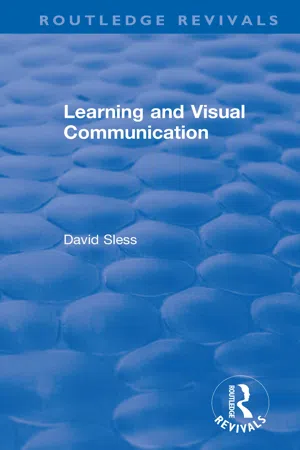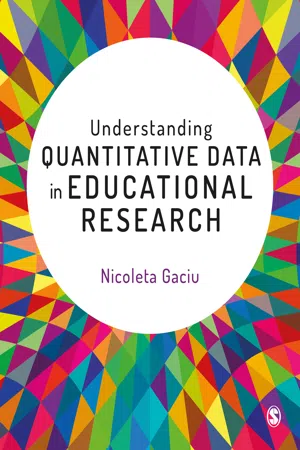Charts and Diagrams
Charts and diagrams are visual representations of data or mathematical concepts. They are used to organize and present information in a clear and concise manner, making it easier to understand complex relationships and patterns. In mathematics, charts and diagrams are commonly used to illustrate mathematical functions, relationships, and statistical data.
8 Key excerpts on "Charts and Diagrams"
- eBook - ePub
Statistics for Psychologists
An Intermediate Course
- Brian S. Everitt(Author)
- 2001(Publication Date)
- Psychology Press(Publisher)
...For this reason researchers who collect data are constantly encouraged by their statistical colleagues to make both a preliminary graphical examination of their data and to use a variety of plots and diagrams to aid in the interpretation of the results from more formal analyses. The prime objective of this approach is to communicate both to ourselves and to others. But just what is a graphical display? A concise description is given by Tufte (1983). Data graphics visually display measured quantities by means of the combined use of points, lines, a coordinate system, numbers, symbols, words, shading and colour. Tufte estimates that between 900 billion (9 × 10 11) and 2 trillion (2 × 10 12) images of statistical graphics are printed each year. Some of the advantages of graphical methods have been listed by Schmid (1954). In comparison with other types of presentation, well-designed charts are more effective in creating interest and in appealing to the attention of the reader. Visual relationships as portrayed by charts and graphs are more easily grasped and more easily remembered. The use of charts and graphs saves time, because the essential meaning of large measures of statistical data can be visualized at a glance (like Chambers and his colleagues, Schmid may perhaps be accused of being prone to a little exaggeration here). Charts and graphs provide a comprehensive picture of a problem that makes for a more complete and better balanced understanding than could be derived from tabular or textual forms of presentation. Charts and graphs can bring out hidden facts and relationships and can stimulate, as well as aid, analytical thinking and investigation. Schmid’s last point is reiterated by the late John Tukey in his observation that “the greatest value of a picture is when it forces us to notice what we never expected to...
- eBook - ePub
- Hugh Coolican(Author)
- 2018(Publication Date)
- Routledge(Publisher)
...Chapter 14 Graphical representation of data This chapter deals with the representation of data sets in charts or graphs. In a bar chart frequencies of data in discrete categories are presented for comparison and this must be done fairly, without visual distortion. Line charts are useful for demonstrating a time series – changes over time in a measure of a person or group. Interval data points, grouped into continuous categories, can be represented graphically as a histogram or as a frequency polygon. Tukey (1977) promoted techniques of exploratory data analysis with an emphasis on thorough examination of patterns before submitting data sets to tests of statistical significance. Two methods are included here: stem and leaf diagrams, and box-plots. SPSS procedures are included for common types of chart. Graphs in general People who dislike statistics nevertheless tend to like drawing graphs. However they are also prone to putting far too many of them into a report to make it look more interesting. It’s worth stopping to think, just what is a graph or chart for? It is not to make your report look more scientific or credible. Basically it transmits useful information to your reader. It should be a way of summing up at a glance the main features of your data or some important aspect of them. If it doesn’t do that, if it isn’t easy to understand completely (without referring to the text in your report) or if it presents the absolutely obvious, then it isn’t a good or useful chart. Before you rush to produce what many students find to be the most artistic part of a psychological research report, do take note of some cautionary advice. Over-production and decoration – don’t scatter charts around your report showing every conceivable arrangement of data and in a profusion of pretty colours and patterns. You should be very parsimonious and only produce what will be helpful, not distracting, to your reader...
- eBook - ePub
- David Sless(Author)
- 2019(Publication Date)
- Routledge(Publisher)
...Unlike photographs or drawings, where it remains largely the case that generalisation is properly beyond our reach, graphs and diagrams provide an area where some generalisation is possible. I shall try to show that this is less due to underlying psychological constructs and more related to a precise matching of material and task definition. Simply, users can perform tasks, if they know precisely what the task is and the material is designed specifically with that task in mind. What may prove more interesting in the long run, in this particular area of visual communication, is not any supposed psychological constants which entice those who seek unreasonable control over the learning process but the prodigious capacity of diagrams to sustain complex visual thinking. I will begin by describing the range of material to be considered and then give an account of the peculiar characteristics of visual thought which graphs and diagrams utilise to such advantage. The lessons of research in the field will then be considered and I will end by tempting the reader to consider the exciting potential of these devices in the future of human intellectual activity. The Range of Material I shall continue to use Duchastel and Waller’s categories as a way of indicating the range of material that will be covered (Duchastel and Waller, 1979). Their next category is what they call ‘Logico-mathematical’, and it involves the uses of visual means for representing ‘mathematical concepts’ (ibid., p. 24). The example they give is a line graph (see Figure 29), which is not so much a mathematical concept as a form of data display. Maintaining our functional stance, its use is most likely to be to provide numerical data of trends. In that context it might serve to illustrate the application of a mathematical concept, but in doing so, it functions metonymically. The category is worth preserving despite the poor example, as it is extremely important...
- eBook - ePub
- Wayne A. Wickelgren(Author)
- 2012(Publication Date)
- Dover Publications(Publisher)
...Such information is very efficiently represented by means of a table written on paper. For an example of the importance of constructing tables to represent information, see the Smith, Jones, Robinson problem in Chapter 7. Similar conclusions apply to graphs and other figures, which may be difficult to accurately imagine and remember purely mentally, without graphic aids. Whatever the reason, experience indicates that pencil and paper representation of information is very useful in problem solving. So do not be lazy. Always have pencil and paper ready when you start to work on problems, and make extensive use of them through all stages of problem solving. DIAGRAMMATIC REPRESENTATION When a problem in some way involves spatial concepts – points, lines, angles, directions, vectors, surfaces or plane figures, solids, contiguity, connectedness, inside, outside, around – diagrammatic representation may be an extremely useful aid to symbolic representation, whether verbal, logical, or algebraic. Even when the problem does not seem to involve any spatial concepts, it sometimes happens that you can form an analogy between the concepts in the problem and spatial concepts, so that you could draw a diagram that might be of some aid in solving the problem. For example, overlapping circles might be used to represent overlapping sets, points to represent elements of a set, and sets of arrows to represent mappings from one set to another. Verbal symbolic representation is probably somewhat more important than visual diagrammatic representation in problem solving and in abstract thinking in general. The communication of the givens, operations, and goals of a problem is largely in verbal symbolic terms. Even when we employ diagrams in the solution of problems, they are usually labeled; that is, symbols are attached to the points, lines, and angles...
- eBook - ePub
Statistical Literacy at School
Growth and Goals
- Jane M. Watson(Author)
- 2013(Publication Date)
- Routledge(Publisher)
...The perception, held by some for many years, that “the graph” was the start and finish of data handling, should be fast disappearing. The wide range of graphical representations that are available sometimes leads to frustration for teachers when they have a limited time to cover graphing and want to cover just the important types of graphs. There are also occasionally disputes among textbook writers and curriculum developers about details of graph production. When is a bar graph a histogram? When does one leave gaps between bars? When does one connect dots with lines? What are the rules to construct the whiskers on a box-and-whisker plot? These issues are not dealt with here and no attempt is made to provide a comprehensive coverage of all possible graphical representations. Specific curriculum documents provide guidance. 4 What is important, and the emphasis of this chapter, is the story that graphs tell about data: how graphs are created to tell the story and how they are interpreted once created. One type of graph however deserves special attention because it is used for some of the tasks introduced in later sections. In some curriculum documents and materials it is referred to as a “line plot,” 5 reflecting the scaled base line above which dots or Xs are piled to represent data values. Because of the confusion with the term line graph, referring to a graph where straight lines connect data points, the term stacked dot plot is used here. 6 It is a more visual phrase that can assist students in distinguishing it from other forms, particularly the line graph. Because graphing of various sorts has been in the mathematics curriculum for a long time, there has been considerable research on student understanding. Some aspects of the cognitive demands of coordinate graphing are common to the needs of plotting algebraic functions as well as statistical representations, whereas other demands are different for the fields of algebra and statistics...
- Daniel Montello, Paul Sutton(Authors)
- 2012(Publication Date)
- SAGE Publications Ltd(Publisher)
...11 DATA DISPLAY: TABLES, GRAPHS, MAPS, VISUALIZATIONS LEARNING OBJECTIVES What are tables best used for, and what are some design alternatives for their construction? What are graphs best used for, and what are some design alternatives for their construction? What are some principles for good graphing? What are some of the special powers of maps, and what are some of their special pitfalls? How are new computer technologies being applied to displaying data in innovative and powerful ways? In Chapter 3, we pointed out that scientific communication occurs not only verbally but also graphically. In Chapter 10, we similarly pointed out that data analysis includes not just mathematical techniques but also graphical techniques. We refer to these graphical techniques for communication and analysis as data display. Data displays depict data patterns rather than literally describe them. This gives data displays exceptional power to help us understand and communicate data. The spatial medium of graphical representation takes advantage of the human visual and spatial cognitive systems, including perception and memory, and the unique semiotic qualities of spatiality – the particular way it symbolically represents information. When depicting information about phenomena that are inherently spatial, as geographers and environmental researchers so often do, data displays can do this at whatever scale and viewing perspective is convenient – you can see it all in a glance. Even nonspatial and nonperceptible information can be spatially and visually displayed. What’s more, data displays allow us to highlight and clarify the relevant properties of phenomena, and omit or downplay the irrelevant. Schematic network subway maps like those used in countless big cities around the world provide a wonderful example of this point (Figure 11.1) Figure 11.1 A fictional subway network map, similar to those used in big cities around the world...
- Joan M. Kenney, Euthecia Hancewicz(Authors)
- 2005(Publication Date)
- ASCD(Publisher)
...It is also a pictorial language that uses visual models to communicate. How teachers use the language of pictures and diagrams to communicate with students and check for understanding is the subject of this chapter. The following scenarios involve students using or creating graphic representations in their mathematics classrooms. The first section, Reading Graphics, shows students dealing with technical usage as they read graphs, charts, and diagrams. What definitions do they assign the mathematical terms that their teachers use? What visual model does the word conjure up for them? How can working with graphic representations provide the teacher with insight into a student's thought processes so that what Pimm (1987) calls "semantic contamination" can be identified and addressed? The second section, Artful Listening in Mathematics, confronts the issue of mathematics' technical syntax. Here, students are drawing to learn. They are not copying exemplars into their notebooks for later reference but rather creating personal images of what they understand. How does syntactical subtlety lead them astray? How can the drawings that they create be a window on their thinking, especially for students who cannot adequately articulate where their confusion lies? Regardless of whether students are reading graphic models or creating them, the teacher's questions play a key role. In addition to providing feedback about student understanding, questions also serve a mediating function, helping students discover what they know (or don't know) as they attempt to construct mathematical meaning. In my role as a classroom-based staff developer, I observe middle school students and collect data for their teachers. After each of the lessons described in this chapter, I met with the teacher to reflect collaboratively on what I had noticed. The major reflection questions that we discussed are included at the end of each case...
- Nicoleta Gaciu(Author)
- 2020(Publication Date)
- SAGE Publications Ltd(Publisher)
...3 Graphical representation of data Chapter Objectives In this chapter, we will: introduce the concept of graphical representation of educational data present key principles for the graphical representation of data consider the essential features of different methods to visualise quantitative data understand how to create and work with tables and graphs in R correctly demonstrate examples from educational research to illustrate the use of graphs and tables for different types of variables and scales of measurement. The graphical representation of data is the process of transformation of data into information through a wide range of graphical displays, including graphs, maps, pictograms and tables in a symbolic representation. This process is a vital part of data analysis that facilitates the process of identifying, interpreting and understanding patterns or trends, which may not be visible in the raw data. It is also a useful and accurate communication tool for a range of educational stakeholders. A proper understanding of graphical display is one of the most important aspects of data analysis for students, teachers and researchers, helping them to avoid mistakes when summarising large data sets and analysing relevant patterns in quantitative data. For anyone engaged in educational research, it is very helpful to find relevant patterns in the graphical representation of data before performing any statistical tests or transforming statistical values into more meaningful concepts. The graphical representation of data depends on the type of quantitative data. For example, to organise and summarise categorical data, a bar graph can be used. For a time series, a line graph is recommended. Small data sets are usually easier to interpret if data is displayed in tabular form...







